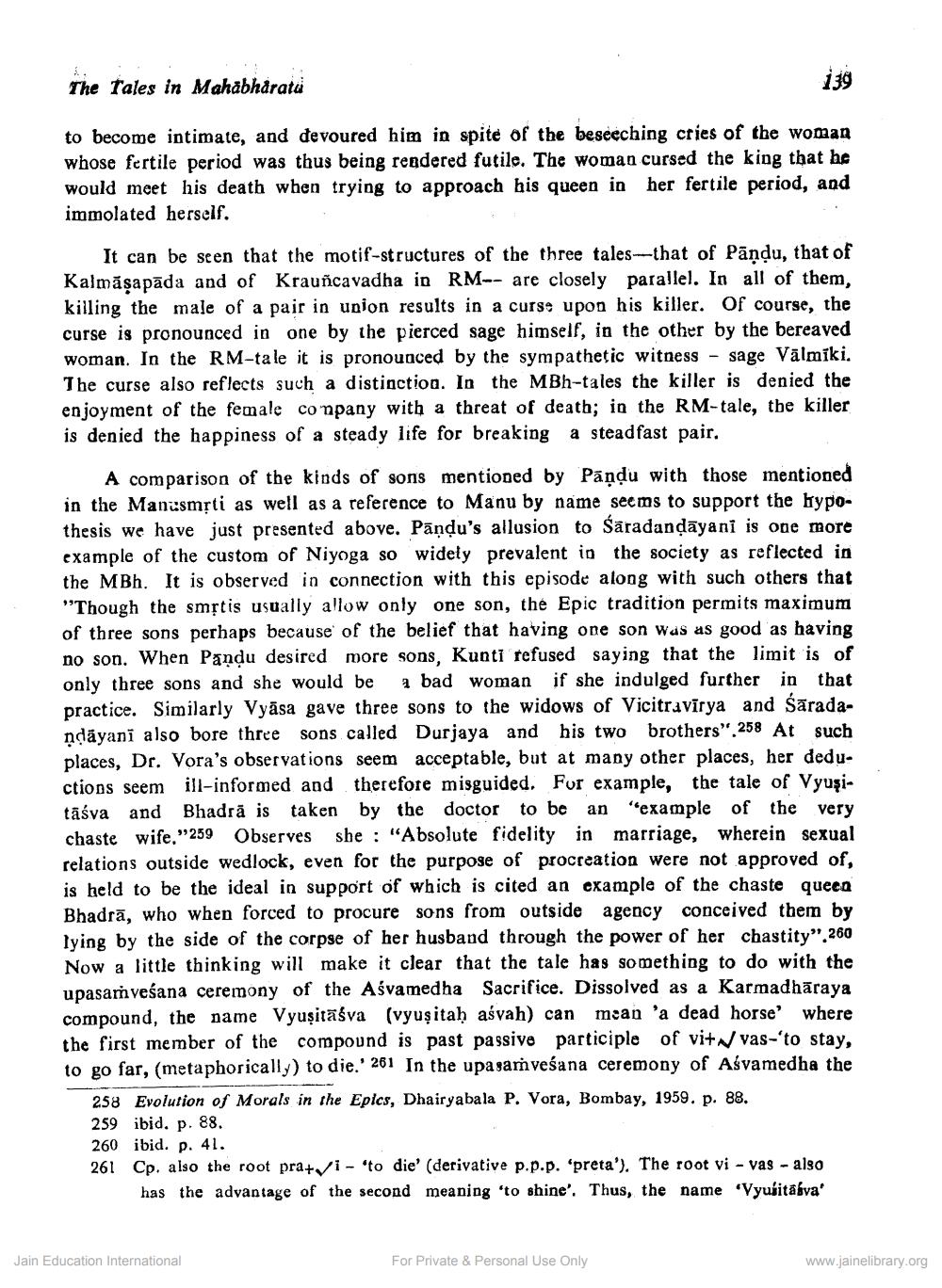________________
The Tales in Mahabharatu
to become intimate, and devoured him in spite of the beseeching cries of the woman whose fertile period was thus being rendered futile. The woman cursed the king that he would meet his death when trying to approach his queen in her fertile period, and immolated herself.
It can be seen that the motif-structures of the three tales--that of Pāndu, that of Kalmășapāda and of Krauñcavadha in RM-- are closely parallel. In all of them, killing the male of a pair in union results in a curse upon his killer. Of course, the curse is pronounced in one by the pierced sage himself, in the other by the bereaved woman. In the RM-tale it is pronounced by the sympathetic witness - sage Vālmīki. The curse also reflects such a distinction. In the MBh-tales the killer is denied the enjoyment of the female company with a threat of death; in the RM-tale, tbe killer is denied the happiness of a steady life for breaking a steadfast pair.
A comparison of the kinds of sons mentioned by Pandu with those mentioned in the Manusmộti as well as a reference to Manu by name seems to support the hypothesis we have just presented above. Pāņdu's allusion to Saradandāyani is one more example of the custom of Niyoga so widely prevalent in the society as reflected in the MBh. It is observed in connection with this episode along with such others that "Though the smrtis usually allow only one son, the Epic tradition permits maximum of three sons perhaps because of the belief that having one son was as good as having no son. When Pandu desired more sons, Kunti refused saying that the limit is of only three sons and she would be a bad woman if she indulged further in that practice. Similarly Vyāsa gave three sons to the widows of Vicitravīrya and sāradandayans also bore three sons called Durjaya and his two brothers". 258 At such places, Dr. Vora's observations seem acceptable, but at many other places, her deductions seem ill-informed and therefore misguided. For example, the tale of Vyuşitāśva and Bhadrā is taken by the doctor to be an "example of the very chaste wife."259 Observes she : "Absolute fidelity in marriage, wherein sexual relations outside wedlock, even for the purpose of procreation were not approved of, is held to be the ideal in support of which is cited an example of the chaste queca Bhadrā, who when forced to procure sons from outside agency conceived them by lying by the side of the corpse of her husband through the power of her chastity". 260 Now a little thinking will make it clear that the tale has something to do with the upasaṁveśana ceremony of the Aśvamedha Sacrifice. Dissolved as a Karmadhāraya compound, the name Vyuşitāśva (vyuşitaḥ aśvah) can mean 'a dead horse' where the first member of the compound is past passive participle of vit vas-'to stay, to go far, (metaphorically) to die.' 261 In the upa samveśana ceremony of Aśvamedha the
258 Evolution of Morals in the Epics, Dhairyabala P. Vora, Bombay, 1959. p. 88. 259 ibid. p. 88. 260 ibid. p. 41. 261 Cp. also the root pra+vi- 'to die' (derivative p.p.p. 'preta'). The root vi - vas - also
has the advantage of the second meaning 'to shine'. Thus, the name 'Vyubitabva'
Jain Education International
For Private & Personal Use Only
www.jainelibrary.org




